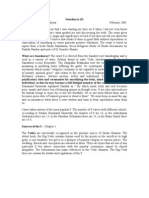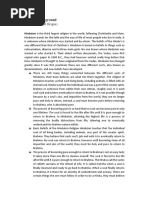Dvija
Dvija
Uploaded by
techzonesCopyright:
Available Formats
Dvija
Dvija
Uploaded by
techzonesOriginal Description:
Copyright
Available Formats
Share this document
Did you find this document useful?
Is this content inappropriate?
Copyright:
Available Formats
Dvija
Dvija
Uploaded by
techzonesCopyright:
Available Formats
Dvija
1
Dvija
Dvija (Sanskrit for "twice-born") is a male member of the first three varnas in Brahmanical Hindu society: the
Brahmins, Kshatriyas, and Vaishyas are included in the Dvija category. The ancient Asvalayana sutra indicates that a
non-dvija child may also be inducted into the Dvija category, if he wishes to pursue the duties associated with these
varnas.
The meaning of the two births
Nepali children performing the sacred thread
ceremony, which marks one's initiation into the
Dvija fold.
"Dvija" means "twice-born": the first birth is physical, while the
second birth is a 'spiritual' one. The second 'birth' occurs when one
uptakes fulfilling a role in society, at the time of Upanayanam
initiation ceremony. For example, a Brahmin is initiated into the
ultimate pursuit of life Brahmopadesam (Preaching/Advising in the
matter of the nature of Brahman, the ultimate reality). Traditionally, a
Kshtraiya would start learning the use of arms, while a Vaishya would
start a trade apprenticeship.
Implications
Only the Dvijas were allowed to perform certain sacred rites and rituals
in the traditional Brahmanical society. Dvija Bandhu is the term for a person born to Dvija parents but not formally
initiated into the Dvija fold (i.e. someone for whom no sacred thread ceremony was performed). Like the women and
the lower castes (the Shudras), the Dvija Bandhus were not eligible for any rites except the marriage rites.
In the traditional Hindu society, a Dvija person was expected to follow the duties as outlined in the Hindu texts,
depending on which stage of life (ashrama) the person is in. This concept says that a Dvija person is to undergo four
stages of life: first, as a student Brahmacharya; then, as a householder Grihastha; then, he shall live in retirement
Vanaprastha; and finally, as an ascetic Sanyasi. The Manusmriti goes into some detail, regarding what is expected of
an individual during each stage.
The Brahmanical centres of learning were open to all the Dvija castes, although they attracted mainly the Brahmin
students.
References
Article Sources and Contributors
2
Article Sources and Contributors
Dvija Source: http://en.wikipedia.org/w/index.php?oldid=602377275 Contributors: Aeusoes1, Andycjp, Ashmoo, Ausjay99, Babub, Colonies Chris, Discospinster, Drjagan, Dsvyas, Kasbee,
LFaraone, Linguisticgeek, Madhava 1947, MatthewVanitas, Mrmuk, Nagarajpaturi, Nijgoykar, Omnipaedista, PhnomPencil, Raj the one, Rich Farmbrough, Rosarino, Titodutta, Utcursch,
Wraithful, 15 anonymous edits
Image Sources, Licenses and Contributors
File:Barthaband Pooja.jpg Source: http://en.wikipedia.org/w/index.php?title=File:Barthaband_Pooja.jpg License: Public Domain Contributors: Yurgan Vishujoyshe
License
Creative Commons Attribution-Share Alike 3.0
//creativecommons.org/licenses/by-sa/3.0/
You might also like
- Dvija Born AgainDocument1 pageDvija Born AgainnieotyagiNo ratings yet
- BrahminismDocument17 pagesBrahminismAjay KumarNo ratings yet
- HinduismDocument2 pagesHinduismapi-307962963100% (1)
- Jainism Is one-WPS OfficeDocument7 pagesJainism Is one-WPS Officeboscosmith89No ratings yet
- Assignment On A Detailed Study of Hindu Religious TraditionDocument6 pagesAssignment On A Detailed Study of Hindu Religious TraditionLal LawmsangaNo ratings yet
- Hinduism: Romans 2:15Document13 pagesHinduism: Romans 2:15Marissa AsimNo ratings yet
- By The Aryans Blend With Native Religions To Produce Classical Hinduism? TheDocument3 pagesBy The Aryans Blend With Native Religions To Produce Classical Hinduism? ThePatrick WallenbergNo ratings yet
- HinduismDocument13 pagesHinduismTrishlaNo ratings yet
- 0 Jartikel - HINDUISM The Religious Dimension of Indian CultureDocument3 pages0 Jartikel - HINDUISM The Religious Dimension of Indian CulturebudimahNo ratings yet
- Unit One: The Indian Religious Background and The Emergence of BuddhismDocument8 pagesUnit One: The Indian Religious Background and The Emergence of BuddhismHbr PscNo ratings yet
- 02 Philosophy of Gandhi @nadalDocument188 pages02 Philosophy of Gandhi @nadalanon_9685930No ratings yet
- Moral Hinduism Buddhism Similarities and DifferencesDocument2 pagesMoral Hinduism Buddhism Similarities and DifferencesShermaljit Singh100% (7)
- Chapter 5 HinduismDocument48 pagesChapter 5 HinduismEdwardJohnG.CalubIINo ratings yet
- Buddhist Wizards (Vidyādhara, Weizzā, Weikza) - Origins and History - Oxford Research Encyclopedia of ReligionDocument31 pagesBuddhist Wizards (Vidyādhara, Weizzā, Weikza) - Origins and History - Oxford Research Encyclopedia of ReligionAmani NavitaNo ratings yet
- Religion Notes - For Students - 3Document7 pagesReligion Notes - For Students - 3chrisjuspNo ratings yet
- Balaji - FinalHAFHinduism101Document3 pagesBalaji - FinalHAFHinduism101WCSS2015No ratings yet
- Concept of Dharma in Hindu Family LawDocument10 pagesConcept of Dharma in Hindu Family LawNifty FiftyNo ratings yet
- Indian Influences On Rastafarianism (2007) BA Thesis Univ OhioDocument53 pagesIndian Influences On Rastafarianism (2007) BA Thesis Univ OhioAbuAbdur-RazzaqAl-Misri100% (1)
- The Graven ImageDocument2 pagesThe Graven ImageShay MitchNo ratings yet
- GuardianshipDocument16 pagesGuardianshipNandini Tarway100% (1)
- Sanskrit Bengali Gujarati Rigveda PIE Greek Latin JnanaDocument5 pagesSanskrit Bengali Gujarati Rigveda PIE Greek Latin JnanaEverything newNo ratings yet
- Faith Traditions (HINDUISM)Document4 pagesFaith Traditions (HINDUISM)Stephanie Ginger KarganillaNo ratings yet
- Religion of BuddhismDocument11 pagesReligion of BuddhismHamna NisarNo ratings yet
- Varna SystemDocument14 pagesVarna SystemlovleshrubyNo ratings yet
- The Illustrated Encyclopedia of Hinduism (2 Vol Set) (PDFDrive) - 11-13Document3 pagesThe Illustrated Encyclopedia of Hinduism (2 Vol Set) (PDFDrive) - 11-13Ashwinbhai TapaniyaNo ratings yet
- The Illustrated Encyclopedia of Hinduism (2 Vol Set) (PDFDrive) - 2Document10 pagesThe Illustrated Encyclopedia of Hinduism (2 Vol Set) (PDFDrive) - 2Ashwinbhai TapaniyaNo ratings yet
- Research Paper - HinduismDocument19 pagesResearch Paper - HinduismagoodNo ratings yet
- MP Singh Chap 1Document8 pagesMP Singh Chap 1Ashish KalerNo ratings yet
- Jainism AssignmentDocument20 pagesJainism Assignment19MME-S1-323 Usman Ul Hassan PirzadaNo ratings yet
- LCMS CTCR Evaluation HinduismDocument5 pagesLCMS CTCR Evaluation HinduismGreg CumbeeNo ratings yet
- JainDocument4 pagesJainVikas AgrawalNo ratings yet
- Parth HistoryDocument18 pagesParth Historyvivek mishraNo ratings yet
- A Note On Caste SystemkDocument6 pagesA Note On Caste Systemkgoldspotter9841No ratings yet
- Legal Aspect of Jain Religion As Separate Entity: Vaibhav Jain, Sanjay JainDocument12 pagesLegal Aspect of Jain Religion As Separate Entity: Vaibhav Jain, Sanjay JainAllen SoNo ratings yet
- L-28 Major Religious Communities in IndiaDocument16 pagesL-28 Major Religious Communities in Indiamusic2850No ratings yet
- HinduismDocument29 pagesHinduismBerham Abdul DahimNo ratings yet
- Q2 World ReligionDocument2 pagesQ2 World ReligionYhel LantionNo ratings yet
- Caste System and Caste DivideDocument16 pagesCaste System and Caste DivideDeepu P.Thomas100% (1)
- ASSIGNMENT Essence of Indian Knowledge and Tradition completeDocument15 pagesASSIGNMENT Essence of Indian Knowledge and Tradition completetmillmgk12No ratings yet
- Indian Religion, Philosophy and PracticesDocument39 pagesIndian Religion, Philosophy and PracticesSudhanshu Tiwari100% (1)
- Samskaras and OriginDocument22 pagesSamskaras and Origins1234tNo ratings yet
- Introduction of Hindu and Buddha DharmaDocument4 pagesIntroduction of Hindu and Buddha DharmaAkhil SreenadhNo ratings yet
- Historical Background (History and Origin)Document11 pagesHistorical Background (History and Origin)rsyahNo ratings yet
- CKKKKKKKKKKKKKKKKKKKK HeyDocument15 pagesCKKKKKKKKKKKKKKKKKKKK HeyGia AlmirañezNo ratings yet
- HinduismDocument8 pagesHinduismRezza Mae PagsolinganNo ratings yet
- Varna (Hinduism) - Wikipedia, The Free EncyclopediaDocument6 pagesVarna (Hinduism) - Wikipedia, The Free Encyclopediaमनीष मैठाणीNo ratings yet
- Hindu DharmaDocument7 pagesHindu DharmaHiraBallabhNo ratings yet
- Comparative Religions - HinduismDocument50 pagesComparative Religions - HinduismRiane SabañecoNo ratings yet
- Q2W3Document5 pagesQ2W3JosephineNo ratings yet
- Hinduism by Pankaj SinghDocument16 pagesHinduism by Pankaj Singhpankaj singhNo ratings yet
- Business Ethics: HinduismDocument11 pagesBusiness Ethics: HinduismfharnizaparasanNo ratings yet
- Hinduism The Origin and Meaning of HinduismDocument10 pagesHinduism The Origin and Meaning of HinduismAmzar NazifNo ratings yet
- Buddhism: Buddhism As Traditionally Conceived Is A Path of Salvation Attained Through Insight Into TheDocument5 pagesBuddhism: Buddhism As Traditionally Conceived Is A Path of Salvation Attained Through Insight Into ThesarayooNo ratings yet
- Buddhism & Hinduism-WickiDocument29 pagesBuddhism & Hinduism-WickiKalaignar ThangarajuNo ratings yet
- HinduismDocument30 pagesHinduismEcho TavaresNo ratings yet
- BackgroundDocument8 pagesBackgroundhey lucy!No ratings yet
- He Teachings of Lord Mahavira (Jainism)Document3 pagesHe Teachings of Lord Mahavira (Jainism)jastine bajoNo ratings yet
- Eastern Philosophy: The Greatest Thinkers and Sages from Ancient to Modern TimesFrom EverandEastern Philosophy: The Greatest Thinkers and Sages from Ancient to Modern TimesRating: 3.5 out of 5 stars3.5/5 (4)
- Einstein Refrigerator PDFDocument4 pagesEinstein Refrigerator PDFtechzones100% (1)
- United ArtistsDocument11 pagesUnited ArtiststechzonesNo ratings yet
- Amiim ExamDocument2 pagesAmiim ExamtechzonesNo ratings yet
- IIM December ExamDocument1 pageIIM December ExamtechzonesNo ratings yet
- IIM December ExamDocument1 pageIIM December ExamtechzonesNo ratings yet
- AMIIM Exam RulesDocument8 pagesAMIIM Exam RulestechzonesNo ratings yet
- Zingiberaceae: Ginger FamilyDocument5 pagesZingiberaceae: Ginger Familytechzones50% (2)
- KagapujandarDocument4 pagesKagapujandartechzones100% (1)
- Differential Calculus-I: Note: 1. If K ( 0) Is The Curvature of A Curve at P, Then The RadiusDocument28 pagesDifferential Calculus-I: Note: 1. If K ( 0) Is The Curvature of A Curve at P, Then The RadiustechzonesNo ratings yet
- Acacia Pycnantha: Golden WattleDocument7 pagesAcacia Pycnantha: Golden WattletechzonesNo ratings yet
- FIFA World CupDocument18 pagesFIFA World CuptechzonesNo ratings yet
- Indian Institute of Metals - Exam DetailsDocument3 pagesIndian Institute of Metals - Exam Detailstechzones50% (2)
- High Temperature CorrosionDocument3 pagesHigh Temperature CorrosiontechzonesNo ratings yet
- Phosphorus CycleDocument5 pagesPhosphorus CycletechzonesNo ratings yet
- Sarangapani TempleDocument5 pagesSarangapani TempletechzonesNo ratings yet
- Sorting AlgorithmDocument13 pagesSorting AlgorithmtechzonesNo ratings yet
- Geothermal EnergyDocument11 pagesGeothermal EnergytechzonesNo ratings yet
- Scientific RevolutionDocument14 pagesScientific Revolutiontechzones100% (2)
- Thuluva VellalarDocument2 pagesThuluva VellalartechzonesNo ratings yet
- BahubaliDocument4 pagesBahubalitechzones100% (1)
- The Story of MacbethDocument1 pageThe Story of MacbethHugoAgsallongReandaNo ratings yet
- Steps On How To Get An Oathtaking Ticket in Philippine Nurses Association (PNA)Document2 pagesSteps On How To Get An Oathtaking Ticket in Philippine Nurses Association (PNA)PhilippineNursingDirectory.comNo ratings yet
- Graduation Day ScriptDocument3 pagesGraduation Day ScriptPartha100% (1)
- Magick Realm MagazineDocument33 pagesMagick Realm MagazineMagick Realm100% (1)
- BowingDocument5 pagesBowingkarmelolazaro14No ratings yet
- LearnEnglish Magazine Halloween 0Document5 pagesLearnEnglish Magazine Halloween 0Tiago Moreira100% (1)
- Spouse Questionnaire 2012Document4 pagesSpouse Questionnaire 2012raliscad12No ratings yet
- ISKF Philippines 2nd World Shotocup BookletDocument43 pagesISKF Philippines 2nd World Shotocup BookletSuper PerezNo ratings yet
- Dara Joy - Cat Scratched!Document67 pagesDara Joy - Cat Scratched!Solarissis100% (1)
- Classroom Recognition (Script)Document2 pagesClassroom Recognition (Script)Armaden MamandiNo ratings yet
- The Churinga or Bull Roarers of The Arunta and Other TribesDocument39 pagesThe Churinga or Bull Roarers of The Arunta and Other TribesRafaela VieiraNo ratings yet
- Sri Valmiki RamayanaDocument12 pagesSri Valmiki RamayanagoshteeNo ratings yet
- Indonesia Traditional Weapon1Document1 pageIndonesia Traditional Weapon1Dewa Agung Ayu Dharmayuni100% (1)
- Agd ScriptDocument13 pagesAgd ScriptdiyanaNo ratings yet
- Lucrare de Atestat La Limba Engleză: Crown Jewels of The United Kingdom and The Personal Jewel Collection of Elizabeth IIDocument8 pagesLucrare de Atestat La Limba Engleză: Crown Jewels of The United Kingdom and The Personal Jewel Collection of Elizabeth IIMihaela AdelaNo ratings yet
- Investiture Ceremonies PDFDocument6 pagesInvestiture Ceremonies PDFVsha NavarraNo ratings yet
- Book, The Return of The VölvaDocument11 pagesBook, The Return of The VölvaManuel H Jardin H100% (2)
- Qualifications For The National Artist AwardDocument13 pagesQualifications For The National Artist AwardELSA100% (2)
- Pagdusay Is A Thanksgiving Ritual On The Agricultural Harvest of The Agta inDocument8 pagesPagdusay Is A Thanksgiving Ritual On The Agricultural Harvest of The Agta inLeo Archival Imperial100% (1)
- Sparta Summary Notes 2016Document17 pagesSparta Summary Notes 2016EmillyNo ratings yet
- FlyerDocument3 pagesFlyersarabala1979No ratings yet
- Elphinstone Community BBQ: Come One Come All To TheDocument8 pagesElphinstone Community BBQ: Come One Come All To Thefiona8026No ratings yet
- Candle: Candle (Disambiguation) Wax Wick AmeDocument9 pagesCandle: Candle (Disambiguation) Wax Wick AmeJim KatNo ratings yet
- Mindanao Festival 2Document7 pagesMindanao Festival 2ggygy7tyhuNo ratings yet
- The Ritual of The Commandery - Knights of Malta 1878 PDFDocument122 pagesThe Ritual of The Commandery - Knights of Malta 1878 PDForvatsNo ratings yet
- Cultura NazcaDocument16 pagesCultura NazcaYleyam RamirezNo ratings yet
- Evening StarDocument2 pagesEvening StarPersonal trainerNo ratings yet
- Wednesday Ceremony ScriptDocument3 pagesWednesday Ceremony ScriptAra NajuuaaaNo ratings yet
- EA InstructionDocument27 pagesEA InstructionTroy Welch100% (1)
- Philippinefolkdance 141117063229 Conversion Gate01 151016091709 Lva1 App6892Document20 pagesPhilippinefolkdance 141117063229 Conversion Gate01 151016091709 Lva1 App6892Jecky Josette AsentistaNo ratings yet












































































































